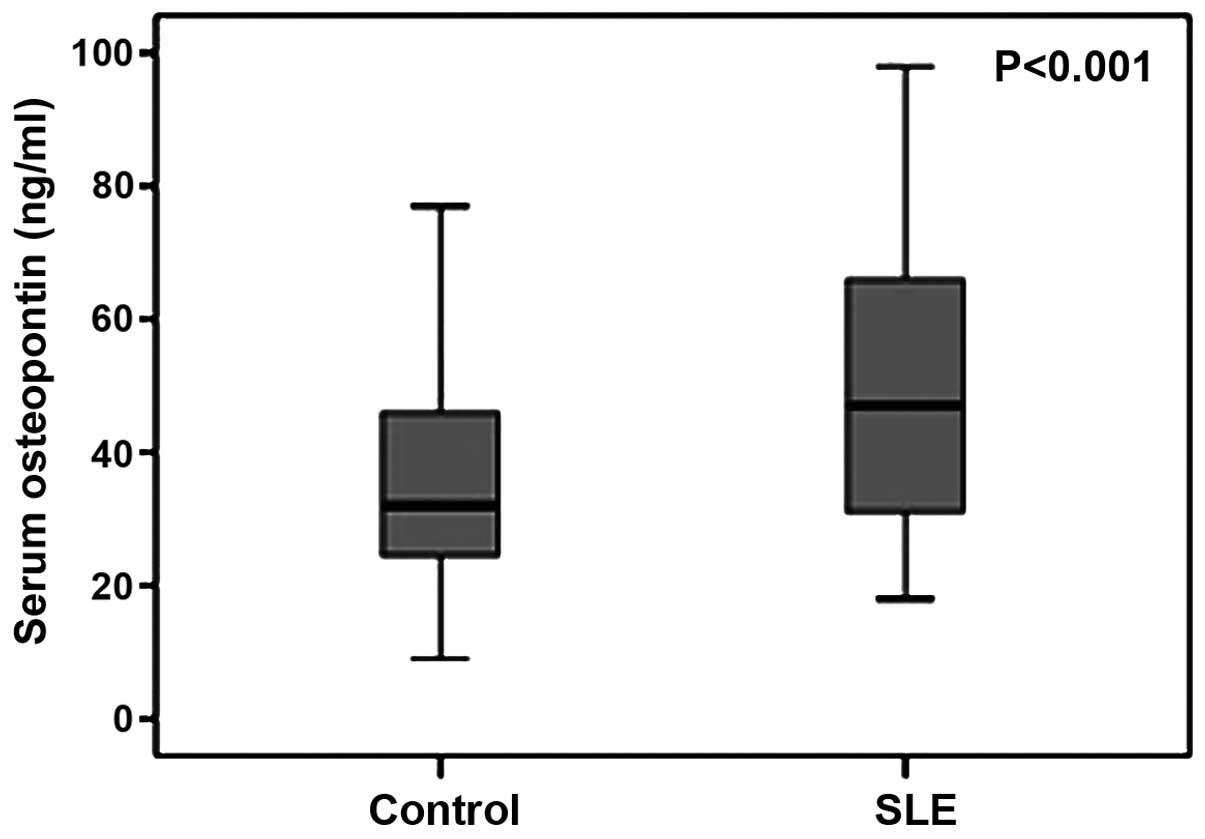|
1
|
Crispín JC, Liossis SN, Kis-Toth K,
Lieberman LA, Kyttaris VC, Juang YT and Tsokos GC: Pathogenesis of
human systemic lupus erythematosus: Recent advances. Trends Mol
Med. 16:47–57. 2010. View Article : Google Scholar : PubMed/NCBI
|
|
2
|
Harley JB, Kelly JA and Kaufman KM:
Unraveling the genetics of systemic lupus erythematosus. Springer
Semin Immunopathol. 28:119–130. 2006. View Article : Google Scholar : PubMed/NCBI
|
|
3
|
Deapen D, Escalante A, Weinrib L, Horwitz
D, Bachman B, Roy-Burman P, Walker A and Mack TM: A revised
estimate of twin concordance in systemic lupus erythematosus.
Arthritis Rheum. 35:311–318. 1992. View Article : Google Scholar : PubMed/NCBI
|
|
4
|
Mazzali M, Kipari T, Ophascharoensuk V,
Wesson JA, Johnson R and Hughes J: Osteopontin - a molecule for all
seasons. QJM. 95:3–13. 2002. View Article : Google Scholar : PubMed/NCBI
|
|
5
|
Christensen B, Kazanecki CC, Petersen TE,
Rittling SR, Denhardt DT and Sorensen ES: Cell type-specific
post-translational modifications of mouse osteopontin are
associated with different adhesive properties. J Biol Chem.
282:19463–19472. 2007. View Article : Google Scholar : PubMed/NCBI
|
|
6
|
Scatena M, Liaw L and Giachelli CM:
Osteopontin: a multifunctional molecule regulating chronic
inflammation and vascular disease. Arterioscler Thromb Vasc Biol.
27:2302–2309. 2007. View Article : Google Scholar : PubMed/NCBI
|
|
7
|
Weber GF, Ashkar S, Glimcher MJ and Cantor
H: Receptor-ligand interaction between CD44 and osteopontin
(Eta-1). Science. 271:509–512. 1996. View Article : Google Scholar : PubMed/NCBI
|
|
8
|
Murugaiyan G, Mittal A and Weiner HL:
Increased osteopontin expression in dendritic cells amplifies IL-17
production by CD4+ T cells in experimental autoimmune
encephalomyelitis and in multiple sclerosis. J Immunol.
181:7480–7488. 2008. View Article : Google Scholar : PubMed/NCBI
|
|
9
|
Briggs TA: Osteopontin - a biomarker for
organ damage in paediatric lupus? Arthritis Res Ther. 15:1102013.
View Article : Google Scholar : PubMed/NCBI
|
|
10
|
Wong CK, Lit LC, Tam LS, Li EK and Lam CW:
Elevation of plasma osteopontin concentration is correlated with
disease activity in patients with systemic lupus erythematosus.
Rheumatology (Oxford). 44:602–606. 2005. View Article : Google Scholar : PubMed/NCBI
|
|
11
|
D'Alfonso S, Barizzone N, Giordano M,
Chiocchetti A, Magnani C, Castelli L, Indelicato M, Giacopelli F,
Marchini M, Scorza R, et al: Two single-nucleotide polymorphisms in
the 5′ and 3 ends of the osteopontin gene contribute to
susceptibility to systemic lupus erythematosus. Arthritis Rheum.
52:539–547. 2005. View Article : Google Scholar : PubMed/NCBI
|
|
12
|
Forton AC, Petri MA, Goldman D and
Sullivan KE: An osteopontin (SPP1) polymorphism is associated with
systemic lupus erythematosus. Hum Mutat. 19:4592002. View Article : Google Scholar : PubMed/NCBI
|
|
13
|
Xu AP, Bai J, Lü J, Liang YY, Li JG, Lai
DY, Wan X and Huang HH: Osteopontin gene polymorphism in
association with systemic lupus erythematosus in Chinese patients.
Chin Med J (Engl). 120:2124–2128. 2007.PubMed/NCBI
|
|
14
|
Hochberg MC: Updating the American College
of Rheumatology revised criteria for the classification of systemic
lupus erythematosus. Arthritis Rheum. 40:17251997. View Article : Google Scholar : PubMed/NCBI
|
|
15
|
Ashkar S, Weber GF, Panoutsakopoulou V,
Sanchirico ME, Jansson M, Zawaideh S, Rittling SR, Denhardt DT,
Glimcher MJ and Cantor H: Eta-1 (osteopontin): An early component
of type-1 (cell-mediated) immunity. Science. 287:860–864. 2000.
View Article : Google Scholar : PubMed/NCBI
|
|
16
|
El-Tanani MK: Role of osteopontin in
cellular signaling and metastatic phenotype. Front Biosci.
13:4276–4284. 2008. View
Article : Google Scholar : PubMed/NCBI
|
|
17
|
Weber GF and Cantor H: The immunology of
Eta-1/osteopontin. Cytokine Growth Factor Rev. 7:241–248. 1996.
View Article : Google Scholar : PubMed/NCBI
|
|
18
|
Weber GF, Zawaideh S, Hikita S, Kumar VA,
Cantor H and Ashkar S: Phosphorylation-dependent interaction of
osteopontin with its receptors regulates macrophage migration and
activation. J Leukoc Biol. 72:752–761. 2002.PubMed/NCBI
|
|
19
|
Shinohara ML, Kim JH, Garcia VA and Cantor
H: Engagement of the type I interferon receptor on dendritic cells
inhibits T helper 17 cell development: Role of intracellular
osteopontin. Immunity. 29:68–78. 2008. View Article : Google Scholar : PubMed/NCBI
|
|
20
|
Lampe MA, Patarca R, Iregui MV and Cantor
H: Polyclonal B cell activation by the Eta-1 cytokine and the
development of systemic autoimmune disease. J Immunol.
147:2902–2906. 1991.PubMed/NCBI
|
|
21
|
Li L, Yu XQ, Yin PD, Chen YX, Liu YG and
Xu HS: OPN expression of peripheral blood mononuclear cells in
systemic lupus erythematosus (SLE) and its clinical significance.
Chin J Rheumatol Chin. 3:84–86. 1999.(In Chinese).
|
|
22
|
Iizuka J: Relationship between osteopontin
expression and autoimmune disease - analysis of osteopontin
expressed in transgenic mice. Hokkaido Igaku Zasshi. 73:487–495.
1998.(In Japanese). PubMed/NCBI
|
|
23
|
Kariuki SN, Moore JG, Kirou KA, Crow MK,
Utset TO and Niewold TB: Age- and gender-specific modulation of
serum osteopontin and interferon-alpha by osteopontin genotype in
systemic lupus erythematosus. Genes Immun. 10:487–494. 2009.
View Article : Google Scholar : PubMed/NCBI
|
|
24
|
Trivedi T, Franek BS, Green SL, Kariuki
SN, Kumabe M, Mikolaitis RA, Jolly M, Utset TO and Niewold TB:
Osteopontin alleles are associated with clinical characteristics in
systemic lupus erythematosus. J Biomed Biotechnol. 2011:8025812011.
View Article : Google Scholar : PubMed/NCBI
|
|
25
|
Xu AP, Liang YY, Lü J, Li JG and Wang Z:
Association of osteopontin gene polymorphism with lupus nephritis
in Chinese Han population. Nan Fang Yi Ke Da Xue Xue Bao.
27:1348–1351. 2007.(In Chinese). PubMed/NCBI
|
|
26
|
Han S, Guthridge JM, Harley IT, Sestak AL,
Kim-Howard X, Kaufman KM, Namjou B, Deshmukh H, Bruner G, Espinoza
LR, et al: Osteopontin and systemic lupus erythematosus
association: A probable gene-gender interaction. PLoS One.
3:e00017572008. View Article : Google Scholar : PubMed/NCBI
|

















